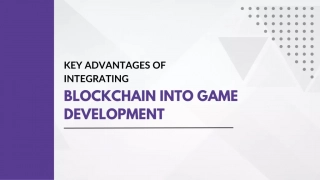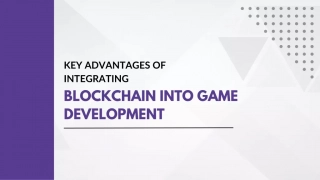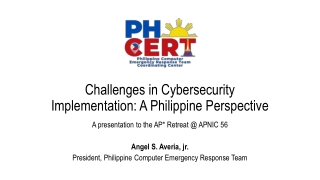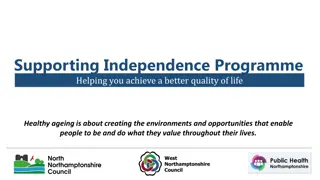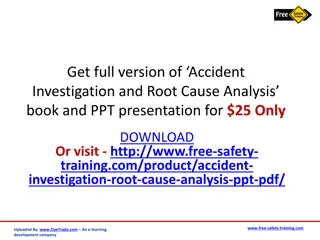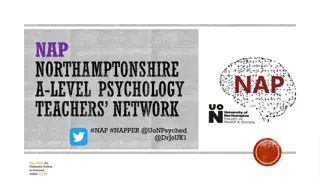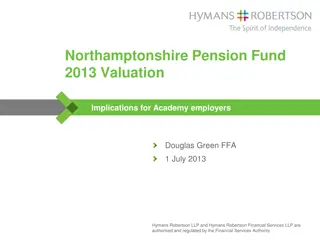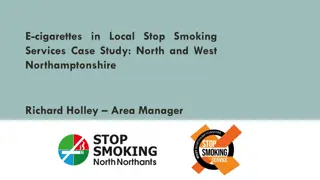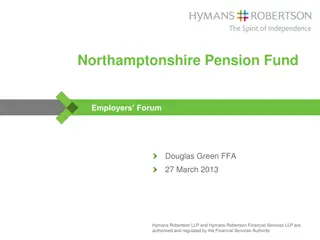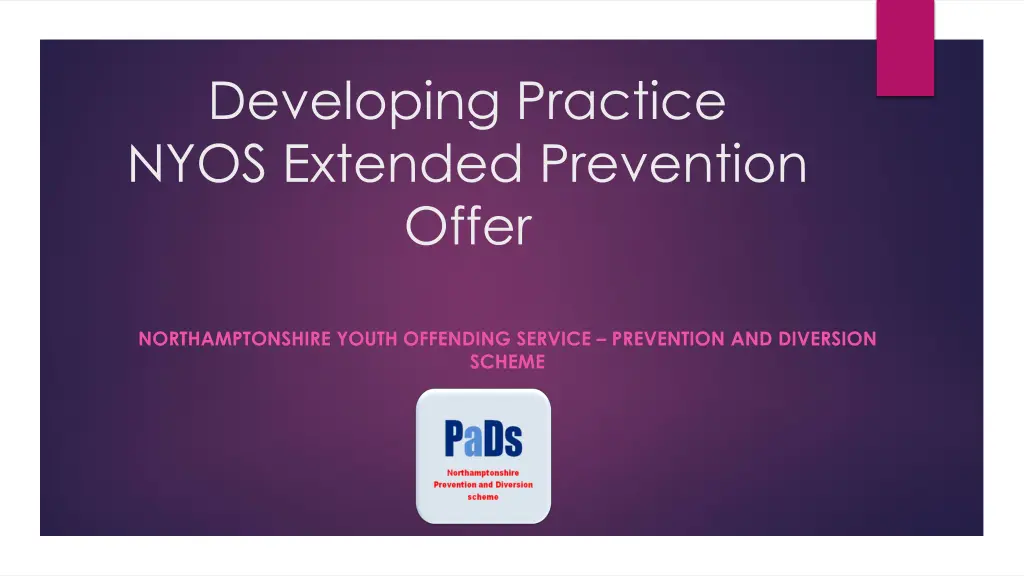
Prevention and Diversion Scheme in Northamptonshire
"Learn about the initiative by Northamptonshire Youth Offending Service to prevent youth involvement in crime, focusing on early intervention and diversion programs. Discover the process, aim, and impact of this vital scheme."
Download Presentation

Please find below an Image/Link to download the presentation.
The content on the website is provided AS IS for your information and personal use only. It may not be sold, licensed, or shared on other websites without obtaining consent from the author. If you encounter any issues during the download, it is possible that the publisher has removed the file from their server.
You are allowed to download the files provided on this website for personal or commercial use, subject to the condition that they are used lawfully. All files are the property of their respective owners.
The content on the website is provided AS IS for your information and personal use only. It may not be sold, licensed, or shared on other websites without obtaining consent from the author.
E N D
Presentation Transcript
Developing Practice NYOS Extended Prevention Offer NORTHAMPTONSHIRE YOUTH OFFENDING SERVICE PREVENTION AND DIVERSION SCHEME
Early Intervention Youth Fund Since the inception of YOSs, Diversionary work which occurred in only some geographic areas has become the norm across the country. That said, not all areas operate in the same way. Some YOSs fulfil their statutory duties via work with young people receiving Youth Cautions and Youth Conditional Cautions. Others go well beyond that, engaging with children subject to Community Restorative Disposals and other outcomes short of entry into the formal justice system. Northamptonshire Youth Offending Service falls into the latter category. PaDs is managed by Northamptonshire Youth Offending Service in partnership with Northamptonshire Police and has been established since 2014. The primary focus of this team was to support young people that had been diverted from Court and the criminal justice system through Out of Court disposals. The next obvious step was to begin a process of working with children who have not (yet) committed offences and in order to achieve that, NYOS joined with the Police in the OPFCC led bid to the Home Office Early Intervention Youth Fund. Success in securing this funding, which the OPFCC agreed to match-fund to the end of March 2021, enabled NYOS to recruit staff to extend our pre-court work capacity into the prevention field and, for the past 18 months, NYOS has been striving to maximise the amount of preventative work we undertake within the service.
Aim The core aim of this work within Northamptonshire has been the reduction in potential violent crime, with a particular focus on dissuading children on the edge of gang involvement from continuing down that path. The project was led by our Police partners through the Community Initiative for Reducing Violent Crime (CIRV) Referrals can come from a variety of sources, and relate to behaviour that might be indicative of an offence, even where the Police have not received a formal report. More recently, knife-enabled incidents, where no substantive offence outcome is possible, have been brought into the process.
Process Initial checks are undertaken, the young person and family are contacted by CIRV navigator consent and willingness to engage in support is confirmed Referral is then discussed in weekly multi- agency triage meeting. A decision is then made as to the most appropriate service to offer support Referral is made into CIRV by schools, parents, community officers, self- referrals, other professionals etc. Referrals are received and considered in the CIRV triage process, and are allocated to the most appropriate provider, e.g. Early Help, CIRV, the ACEs team or PaDs. Signs of Safety is used by all agencies which offers a common language when discussing referrals
Process cont. As assessment is undertaken with the young person and family using our short form summary assessment, timelines and additional screening tools On receipt of the referral coming into PaDs an allocated worker is identified, who will make contact with the young person and family An intervention plan is then agreed with the young person and family and will be implemented swiftly
Trauma and Resilience Towards the end of 2019 we added an additional assessment tool which aims to explore trauma and resilience, and look behind the presenting behaviour. These additional tools support in exploring the why and how as opposed to just the what Timelines allocated workers support the young people in completing timelines reflecting on their positive and negative experiences and opening up discussions about the longer term impact of these experiences Screening tools we developed screening tools to use which support in assessment the current impact of previous experiences and any strengths presented Training training was provided to staff to support them in the use of these tools and how they might shape their assessments and interventions
Band 1 Band 2 Band 3 Low Trauma, high resilience Medium Trauma, medium resilience Cases are identified as requiring Tier 3 intervention. High Trauma, low resilience Cases are identified as requiring Tier 2 intervention: referral to further local partner agencies: Case are identified as requiring Tier 4 services and intervention. Intervention completed by PaDs case manager incorporating Risk and safety and wellbeing concerns. Low level intervention completed by PaDs case manager incorporating Risk and safety and wellbeing concerns. Early Help Targeted support Service 6 counselling service Low Down counselling service Free to talk counselling service Schools Youth club provisions Locality connectors Substantial intervention focusing on trauma and resilience to be supported by CAMHS, Social Services. Additional intervention focusing on trauma and resilience. Access to Health and Justice practitioners. Multi agency response to risk concerns. Access to all of YOS resources and in house multi agency practitioners. Multi agency response by specific identified services. Access to all of YOS resources and in house multi agency practitioners. Intervention timescale up to 6 months. All cases will have PADS case manager oversight of intervention plan completion for a period of 3 months prior to case closure. Intervention timescale up to 6 months. Case closed on completion and management signoff of appropriate exit plan. Case closed on completion and signoff of appropriate exit plan.
Interventions Intervention packages are individual to each young person depending on risk, need and their views and wishes Intervention plans incorporate any support being offered by other services to avoid duplication for that young person Contact levels are considerate of risk, safety and wellbeing concerns and the needs and learning styles of the young person Child focused and friendly SMART it is important for the young person to be able to identify progression and success Emphasis on developing strengths Restorative approaches whilst there is no specific crime or victim we continue to ensure that there is a focus on restorative processes throughout any intervention. In prevention this often centres around community engagement
Case example 1 Young person was referred into PaDs via CIRV triage as there were concerns in relation to his negative associations, cannabis use and the fact he had been known to carry a knife. Through the assessment process this young person identified that he would like support in relation to his anger, the friendships he chooses, and accessing positive activities. In response an intervention plan was agreed looking at support around the things that were important to him but also incorporating work around knife crime and cannabis use. This young person was fully engaged throughout interventions, he then went on to complete our group work programme focusing on masculinity and communities and then joined our Youth Forum, which provided an opportunity for him to feel like he was being heard and making positive contributions in his community. He received a vocational accreditation via ASDAN for the work he completed
Case example 2 Another young person was referred into PaDs due to growing concerns regarding possession of weapons and fire setting. Through assessment it was identified that there were concerns around his emotional wellbeing, a referral was made to our Health and Justice Practitioner who provided more therapeutic support and referrals were made for further assessments. Alongside this we completed intervention exploring the risks around carrying weapons and fire-setting. Our accommodation service also supported his mother as the family were struggling financially and the home they were living in was in disrepair. The young person is now in receipt of ongoing support, the home is being repaired and the family as a whole are coping much better.
Successes Engagement Our engagement rate is high for this voluntary approach, sitting at over 80% We have engaged young people of various ages, ethnic and social backgrounds and from varying locations across the county, that without this project would not have been offered support We have received total of 197 referrals from Feb 19 Feb 21 Rate of engagement Partnership working we have strengthened our engagement with partners with an increase in collaborative working RATE OF ENGAGEMENT FROM REFERRAL TO COMPLETED 82.10% RATE OF ENGAGEMENT FROM ASSESSMENT TO Feedback we seek feedback from young people and families at the end of any intervention. This can highlight the individual successes in the work we have completed 90.60% RATE OF ENGAGEMENT FROM REFERRAL TO ASSESSMENT 90.60% 75.00% 80.00% 85.00% 90.00% 95.00%
Becoming established Challenges The need to ensure there is no duplication for the young person Duplication of referrals for diversion and prevention intervention Non-engagement Complexities Measuring impact Resources staffing/capacity COVID 19
Next steps Committed to continuing with our extended prevention offer, with a view to this being embedded within our service Review of assessment tools What is working well? What needs to be changed to achieve continued improvement Top suspects in crime We have recently started to explore ways to offer this service to a wider network of young people and have worked with our Police colleagues in identifying young people who have been a named suspect in 4 or more crimes in the past 12 months. These young people will come through the triage process as already explained Exploring other referral routes working with partners building even stronger links to aid swift responses to emerging need Developing specific Performance Indicators to measure impact and success measuring not only a reduction in FTE but also the gravity/frequency of offending, engagement in support and ETE, community impact
Northamptonshire YOS Prevention Strategy 2021- 2023 Our Prevention Strategy outlines our commitment to continue our prevention work with the following set of principles on which the development of prevention service will be based; NYOS will offer preventative services to children aged 10 and over. NYOS will work with children identified as being involved in, or significantly likely to be involved in criminal activities NYOS will focus particular effort on children identified as being subject to criminal exploitation NYOS will seek to build a wider consensus and series of processes which prioritise the presenting needs of the child for active and swift assistance from an identified lead agency. NYOS will work with children to explore past events in the context of their current behaviour, taking account of trauma and resilience, in addition to supporting strengths NYOS will consciously use Restorative Practices in its preventative work. Throughout our work, NYOS will seek to engage the child in mainstream, sustainable community services as soon as possible
Thank you for listening QUESTIONS?



